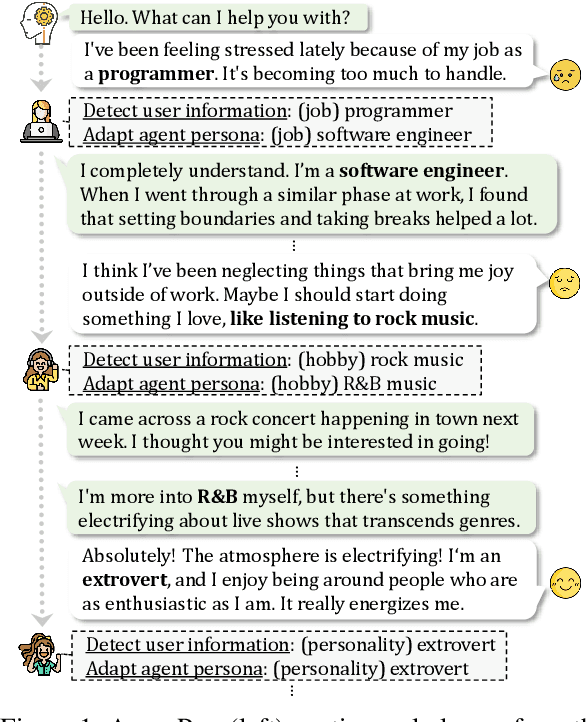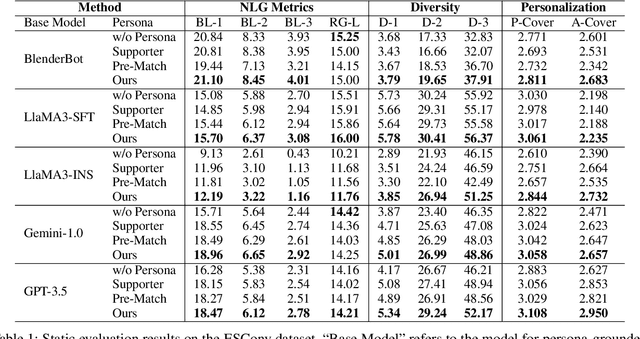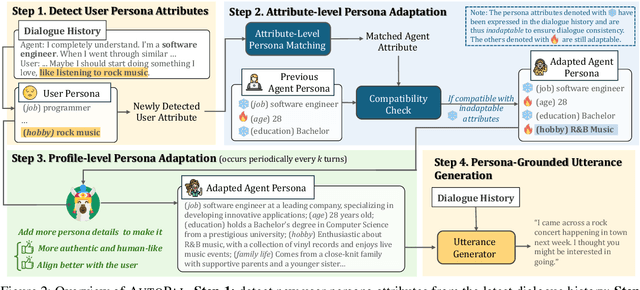Yi Cheng
Learning to Align Multi-Faceted Evaluation: A Unified and Robust Framework
Feb 26, 2025Abstract:Large Language Models (LLMs) are being used more and more extensively for automated evaluation in various scenarios. Previous studies have attempted to fine-tune open-source LLMs to replicate the evaluation explanations and judgments of powerful proprietary models, such as GPT-4. However, these methods are largely limited to text-based analyses under predefined general criteria, resulting in reduced adaptability for unseen instructions and demonstrating instability in evaluating adherence to quantitative and structural constraints. To address these limitations, we propose a novel evaluation framework, ARJudge, that adaptively formulates evaluation criteria and synthesizes both text-based and code-driven analyses to evaluate LLM responses. ARJudge consists of two components: a fine-tuned Analyzer that generates multi-faceted evaluation analyses and a tuning-free Refiner that combines and refines all analyses to make the final judgment. We construct a Composite Analysis Corpus that integrates tasks for evaluation criteria generation alongside text-based and code-driven analysis generation to train the Analyzer. Our results demonstrate that ARJudge outperforms existing fine-tuned evaluators in effectiveness and robustness. Furthermore, it demonstrates the importance of multi-faceted evaluation and code-driven analyses in enhancing evaluation capabilities.
Training an LLM-as-a-Judge Model: Pipeline, Insights, and Practical Lessons
Feb 05, 2025Abstract:The rapid advancement of large language models (LLMs) has opened new possibilities for their adoption as evaluative judges. This paper introduces Themis, a fine-tuned LLM judge that delivers sophisticated context-aware evaluations. We provide a comprehensive overview of the development pipeline for Themis, highlighting its scenario-dependent evaluation prompts and two novel methods for controlled instruction generation. These designs enable Themis to effectively distill evaluative skills from teacher models, while retaining flexibility for continuous development. We introduce two human-labeled benchmarks for meta-evaluation, demonstrating that Themis can achieve high alignment with human preferences in an economical manner. Additionally, we explore insights into the LLM-as-a-judge paradigm, revealing nuances in performance and the varied effects of reference answers. Notably, we observe that pure knowledge distillation from strong LLMs, though common, does not guarantee performance improvement through scaling. We propose a mitigation strategy based on instruction-following difficulty. Furthermore, we provide practical guidelines covering data balancing, prompt customization, multi-objective training, and metric aggregation. We aim for our method and findings, along with the fine-tuning data, benchmarks, and model checkpoints, to support future research and development in this area.
Sigma: Differential Rescaling of Query, Key and Value for Efficient Language Models
Jan 23, 2025



Abstract:We introduce Sigma, an efficient large language model specialized for the system domain, empowered by a novel architecture including DiffQKV attention, and pre-trained on our meticulously collected system domain data. DiffQKV attention significantly enhances the inference efficiency of Sigma by optimizing the Query (Q), Key (K), and Value (V) components in the attention mechanism differentially, based on their varying impacts on the model performance and efficiency indicators. Specifically, we (1) conduct extensive experiments that demonstrate the model's varying sensitivity to the compression of K and V components, leading to the development of differentially compressed KV, and (2) propose augmented Q to expand the Q head dimension, which enhances the model's representation capacity with minimal impacts on the inference speed. Rigorous theoretical and empirical analyses reveal that DiffQKV attention significantly enhances efficiency, achieving up to a 33.36% improvement in inference speed over the conventional grouped-query attention (GQA) in long-context scenarios. We pre-train Sigma on 6T tokens from various sources, including 19.5B system domain data that we carefully collect and 1T tokens of synthesized and rewritten data. In general domains, Sigma achieves comparable performance to other state-of-arts models. In the system domain, we introduce the first comprehensive benchmark AIMicius, where Sigma demonstrates remarkable performance across all tasks, significantly outperforming GPT-4 with an absolute improvement up to 52.5%.
Memory-Augmented Multimodal LLMs for Surgical VQA via Self-Contained Inquiry
Nov 17, 2024



Abstract:Comprehensively understanding surgical scenes in Surgical Visual Question Answering (Surgical VQA) requires reasoning over multiple objects. Previous approaches address this task using cross-modal fusion strategies to enhance reasoning ability. However, these methods often struggle with limited scene understanding and question comprehension, and some rely on external resources (e.g., pre-extracted object features), which can introduce errors and generalize poorly across diverse surgical environments. To address these challenges, we propose SCAN, a simple yet effective memory-augmented framework that leverages Multimodal LLMs to improve surgical context comprehension via Self-Contained Inquiry. SCAN operates autonomously, generating two types of memory for context augmentation: Direct Memory (DM), which provides multiple candidates (or hints) to the final answer, and Indirect Memory (IM), which consists of self-contained question-hint pairs to capture broader scene context. DM directly assists in answering the question, while IM enhances understanding of the surgical scene beyond the immediate query. Reasoning over these object-aware memories enables the model to accurately interpret images and respond to questions. Extensive experiments on three publicly available Surgical VQA datasets demonstrate that SCAN achieves state-of-the-art performance, offering improved accuracy and robustness across various surgical scenarios.
Subtle Errors Matter: Preference Learning via Error-injected Self-editing
Oct 09, 2024



Abstract:Large Language Models (LLMs) have exhibited strong mathematical reasoning and computational prowess, tackling tasks ranging from basic arithmetic to advanced competition-level problems. However, frequently occurring subtle errors, such as miscalculations or incorrect substitutions, limit the models' full mathematical potential. Existing studies to improve mathematical ability typically involve distilling reasoning skills from stronger LLMs or applying preference learning to step-wise response pairs. Although these methods leverage samples of varying granularity to mitigate reasoning errors, they overlook the frequently occurring subtle errors. A major reason is that sampled preference pairs involve differences unrelated to the errors, which may distract the model from focusing on subtle errors. In this work, we propose a novel preference learning framework called eRror-Injected Self-Editing (RISE), which injects predefined subtle errors into partial tokens of correct solutions to construct hard pairs for error mitigation. In detail, RISE uses the model itself to edit a small number of tokens in the solution, injecting designed subtle errors. Then, pairs composed of self-edited solutions and their corresponding correct ones, along with pairs of correct and incorrect solutions obtained through sampling, are used together for subtle error-aware DPO training. Compared with other preference learning methods, RISE further refines the training objective to focus on predefined errors and their tokens, without requiring fine-grained sampling or preference annotation. Extensive experiments validate the effectiveness of RISE, with preference learning on Qwen2-7B-Instruct yielding notable improvements of 3.0% on GSM8K and 7.9% on MATH.
Integrative Decoding: Improve Factuality via Implicit Self-consistency
Oct 02, 2024Abstract:Self-consistency-based approaches, which involve repeatedly sampling multiple outputs and selecting the most consistent one as the final response, prove to be remarkably effective in improving the factual accuracy of large language models. Nonetheless, existing methods usually have strict constraints on the task format, largely limiting their applicability. In this paper, we present Integrative Decoding (ID), to unlock the potential of self-consistency in open-ended generation tasks. ID operates by constructing a set of inputs, each prepended with a previously sampled response, and then processes them concurrently, with the next token being selected by aggregating of all their corresponding predictions at each decoding step. In essence, this simple approach implicitly incorporates self-consistency in the decoding objective. Extensive evaluation shows that ID consistently enhances factuality over a wide range of language models, with substantial improvements on the TruthfulQA (+11.2%), Biographies (+15.4%) and LongFact (+8.5%) benchmarks. The performance gains amplify progressively as the number of sampled responses increases, indicating the potential of ID to scale up with repeated sampling.
MBC: Multi-Brain Collaborative Control for Quadruped Robots
Sep 24, 2024Abstract:In the field of locomotion task of quadruped robots, Blind Policy and Perceptive Policy each have their own advantages and limitations. The Blind Policy relies on preset sensor information and algorithms, suitable for known and structured environments, but it lacks adaptability in complex or unknown environments. The Perceptive Policy uses visual sensors to obtain detailed environmental information, allowing it to adapt to complex terrains, but its effectiveness is limited under occluded conditions, especially when perception fails. Unlike the Blind Policy, the Perceptive Policy is not as robust under these conditions. To address these challenges, we propose a MBC:Multi-Brain collaborative system that incorporates the concepts of Multi-Agent Reinforcement Learning and introduces collaboration between the Blind Policy and the Perceptive Policy. By applying this multi-policy collaborative model to a quadruped robot, the robot can maintain stable locomotion even when the perceptual system is impaired or observational data is incomplete. Our simulations and real-world experiments demonstrate that this system significantly improves the robot's passability and robustness against perception failures in complex environments, validating the effectiveness of multi-policy collaboration in enhancing robotic motion performance.
Structural Optimization of Lightweight Bipedal Robot via SERL
Aug 28, 2024



Abstract:Designing a bipedal robot is a complex and challenging task, especially when dealing with a multitude of structural parameters. Traditional design methods often rely on human intuition and experience. However, such approaches are time-consuming, labor-intensive, lack theoretical guidance and hard to obtain optimal design results within vast design spaces, thus failing to full exploit the inherent performance potential of robots. In this context, this paper introduces the SERL (Structure Evolution Reinforcement Learning) algorithm, which combines reinforcement learning for locomotion tasks with evolution algorithms. The aim is to identify the optimal parameter combinations within a given multidimensional design space. Through the SERL algorithm, we successfully designed a bipedal robot named Wow Orin, where the optimal leg length are obtained through optimization based on body structure and motor torque. We have experimentally validated the effectiveness of the SERL algorithm, which is capable of optimizing the best structure within specified design space and task conditions. Additionally, to assess the performance gap between our designed robot and the current state-of-the-art robots, we compared Wow Orin with mainstream bipedal robots Cassie and Unitree H1. A series of experimental results demonstrate the Outstanding energy efficiency and performance of Wow Orin, further validating the feasibility of applying the SERL algorithm to practical design.
Reasoning Like a Doctor: Improving Medical Dialogue Systems via Diagnostic Reasoning Process Alignment
Jun 20, 2024



Abstract:Medical dialogue systems have attracted significant attention for their potential to act as medical assistants. Enabling these medical systems to emulate clinicians' diagnostic reasoning process has been the long-standing research focus. Previous studies rudimentarily realized the simulation of clinicians' diagnostic process by fine-tuning language models on high-quality dialogue datasets. Nonetheless, they overly focus on the outcomes of the clinician's reasoning process while ignoring their internal thought processes and alignment with clinician preferences. Our work aims to build a medical dialogue system that aligns with clinicians' diagnostic reasoning processes. We propose a novel framework, Emulation, designed to generate an appropriate response that relies on abductive and deductive diagnostic reasoning analyses and aligns with clinician preferences through thought process modeling. Experimental results on two datasets confirm the efficacy of Emulation. Crucially, our framework furnishes clear explanations for the generated responses, enhancing its transparency in medical consultations.
Evolving to be Your Soulmate: Personalized Dialogue Agents with Dynamically Adapted Personas
Jun 20, 2024



Abstract:Previous research on persona-based dialogue agents typically preset the agent's persona before deployment, which remains static thereafter. In this paper, we take a step further and explore a new paradigm called Self-evolving Personalized Dialogue Agents (SPDA), where the agent continuously evolves during the conversation to better align with the user's anticipation by dynamically adapting its persona. This paradigm could enable better personalization for each user, but also introduce unique challenges, which mainly lie in the process of persona adaptation. Two key issues include how to achieve persona alignment with the user and how to ensure smooth transition in the adaptation process. To address them, we propose a novel framework that refines the persona at hierarchical levels to progressively align better with the user in a controllable way. Experiments show that integrating the personas adapted by our framework consistently enhances personalization and overall dialogue performance across various base systems.
 Add to Chrome
Add to Chrome Add to Firefox
Add to Firefox Add to Edge
Add to Edge